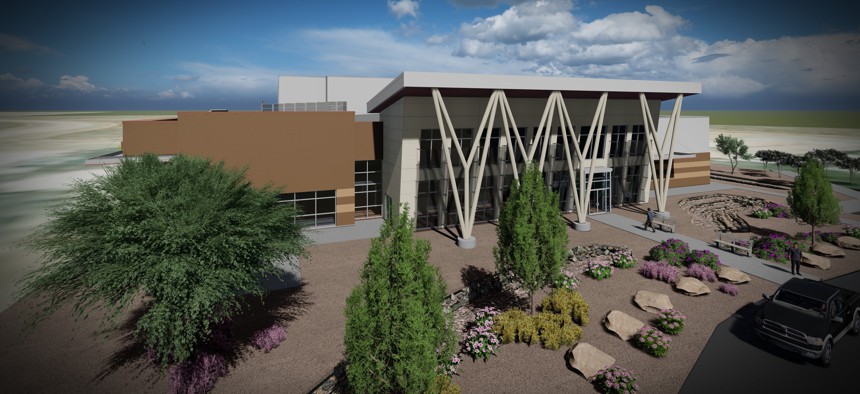
An artist's conception of the Air Force's Joint Simulation Environment, which is slated to open in summer 2024 at Edwards Air Force Base, California. U.S. Air Force
Data-rights fight may delay training on Air Force's new F-35 simulator
Disagreement with Lockheed may stall installation of latest software in a next-gen training facility.
Editor's note: This story was updated at 1:42 p.m. July 18.
EDWARDS AIR FORCE BASE, California—A fight over data may prevent U.S. Air Force pilots from training on the newest version of the F-35 when the service’s next-gen flight simulator opens next summer.
Planemaker Lockheed Martin and the F-35 Joint Program Office have yet to agree on terms for equipping the facility, known as the Joint Simulation Environment, with the data needed to replicate the still-under-development Block 4 upgrade, said Lt. Col. James Petersen, commander of the Air Force’s 445th Test Squadron here.
“Some of that is out of our hands because of the contracting actions required between the JPO and Lockheed Martin,” Petersen said. “Once we are able to get a hold of that licensing and the software, then we'll have that installed. We already have all the hardware purchased and on delivery coming in right now. And we'll be throwing that into the building as soon as we can.”
During a recent visit, the brand-new building smelled of fresh paint, its empty domes awaiting their ersatz cockpits. But even if the simulator facility opens on time, it’s not clear whether the updated jets themselves will be ready.
“I don't think we'll have Block-4 F-35s up and running here next year. That's a little bit further out,” Petersen said.
Lockheed owns the technical data rights for the F-35 program, which means the Pentagon must pay the company to install new weapons, software, or hardware on the jets or in training simulators. This gives the company a significant amount of power to manage sustainment costs of the aircraft.
“We are working with our industry partners on a resolution to the data-rights issue,” said F-35 program spokesperson Russ Goemaere. “While negotiations are ongoing, we cannot comment any further.”
Asked when Lockheed will give the data to the Pentagon for the simulator, a company spokesperson said, “In general, it is our practice not to comment on pending litigation.”
In recent years, the Pentagon has looked to purchase more data rights from companies up front, which officials say will allow for more competition over the decades that weapons like fighter jets, ships, and armored vehicles remain in service.
Air Force Secretary Frank Kendall previously told reporters that the service’s highly secret new fighter jet, known as Next Generation Air Dominance, or NGAD, won’t repeat a “serious mistake” it made with the F-35 program by allowing a contractor to retain ownership of data rights.
The new facility at Edwards will eventually hold four F-35 and four F-22 virtual cockpits, with an additional “two high bays for other future customers,” Petersen said.
“I think we have some future candidates that are eyeing the two empty bays up there,” Petersen said.
Edwards will test a host of new technologies in the coming years, including the B-21 stealth bomber and NGAD.
The Air Force is also building similar threat simulators at Nellis Air Force Base in Nevada. That facility will be ready six to nine months after Edwards’.
Both facilities will focus on developmental and operational test support, but they could also assist with high-end training if needed, Petersen said.
The facility creates a digital version of an open-air range or battlespace, allowing pilots to test out operations and capabilities in a protected space, away from prying adversary eyes.
“Our purpose is to support the testing that they could not accomplish otherwise on an open air range, whether that's because of density or because of classification issues of the exercise. This is a closed space, they can freely do that, without any fear of compromise. And repeatability, you have the control over the environment, you can repeat the same kinds of tasks,” Petersen said.
Edwards is taking lessons from the Navy’s digital test and training range facility at Naval Air Station Patuxent River, Maryland, as it builds its facility.
While Petersen couldn’t comment on NGAD, he said future aircraft coming into the JSE likely wouldn’t use the same setup as F-35s and F-22s. The program is pushing for “extended reality” goggles to be integrated into the JSE for future testing, he said.
“XR” goggles are similar to virtual-reality headsets, except there are cameras on the front that allow an operator to see their hands and the real cockpit, Petersen said, “and then they have that seam line between cockpit and outside a cockpit where it then lets you see the virtual world.”
“That I would think is probably the most likely solution, so you have lower cost, smaller footprint so you can fit more cockpits into a given space, and probably in the two to three years’ timeframe from now, I think that would be a viable technology with JSE by then,” he said.
The Air Force will need more JSEs beyond Edwards and Nellis, Petersen said, because there isn’t enough physical capacity to test all of the new tech. Air Combat Command has already funded an effort to start work on an Alaska instantiation, he said.
“If you want to be able to get the throughput for high-end training, which is currently not being accomplished today, there are going to need to be more,” he said.


